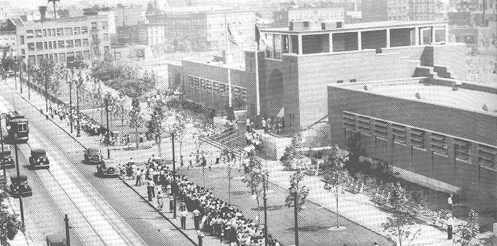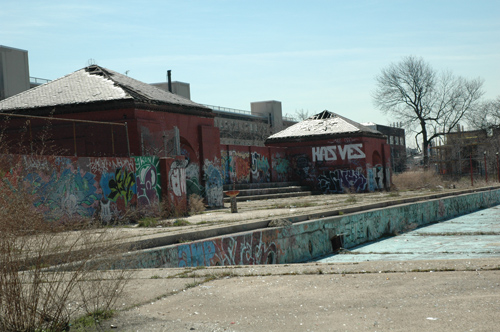
Today is the 70th anniversary of the dedication of McCarren Pool on July 31, 1936. McCarren Pool, which ceased operating as a pool in 1984, was the eighth of eleven giant pools built by Robert Moses and the Works Progress Administration that opened during the summer of 1936, which in and of itself is hard to imagine after generations of public disinvestment in amenities like parks and public swimming pools.
Mayor Fiorello LaGuardia cut the ribbon at McCarren pool on July 31, saying “no pool anywhere has been as much appreciated as this one.” It was built to handle 6,800 swimmers–by 1930s standards, in any case–and cost $1 million to build. The Mayor and Moses opened one city pool a week during the summer of 1936, an interesting factoid in and of itself, given that it would never happen today without a major corporation footing the bill, because city and state government don’t invest in facilities like these–or in parks, for that matter, unless they have a “funding mechanism”– anymore.)
The Parks Department website says “the pool served as the summertime social hub for Greenpoint and Williamsburg” and that “the building’s vast scale and dramatic arches, designed by Aymar Embury II, typify the generous and heroic spirit of New Deal architecture.”
The sad fate of McCarren pool–all the years of abandonment and rot–are another matter. A 2003 article in Free Williamsburg provides a look at the hows and whys of McCarren Pool’s closure in the first place:
In 1979, the city approved $100 million to restore the entire network of pools (many of which had fallen into a state of disrepair and neglect due to the fiscal crisis of the 70’s that had forced major cutbacks in upkeep and security) so they would all be ready for the 50th anniversary celebration in 1986.
The pool was closed in 1983 to begin repairs and then the community said no. A blockade of residents protested fixing the pool up, citing the petty crime and undesirables it attracted. (I was sitting in The Charleston one afternoon at happy hour last year, talking to a long-time resident who was near me at the bar. The pool came up in conversation and he claimed [proudly] he was part of the effort to close it down back then “one way or the other, to keep the coloreds out.” Officials and other people I talked with for the article admitted times were different back then.)
Enter politics. A task force was set up to determine how to overcome the community divide. A recommendation was issued to shrink the size of the pool and demolish the bathhouses that issued out of the sides of the arch.
“That was a stupid idea. The archway and the bathhouses are world-renowned pieces of architecture. The highness of the arch to the long, low-slung bathhouses creates a unique silhouette. Besides, it was illegal to tear it down if there were no plans for its future,” explained Phyllis Yampolsky, head of the McCarren Park Conservancy, a private advocacy group.
There were no plans for its future. The demolition was put on hold, and Yampolsky began her fight to restore the arch and renovate the property. Community Board 1 had other ideas, and division ruled again.
Of the subsequent decay, Francis Morrone wrote that it was New York’s “most poignant ruin” and “a monument to shame.” The pool was finally revived last year and is hosting a full summer of programming this year, some of it not without controversy.
While McCarren Pool escaped the wrecking ball and being filled in, it’s fate is still in the balance. Returning it to use as a pool will cost tens of millions of dollars, money the Parks Department insists it doesn’t have. Unless, of course, a corporate angel wants to step up and return one of the grandest of the New Deal era NYC swimming pools to public use as a pool for Brooklynites.

